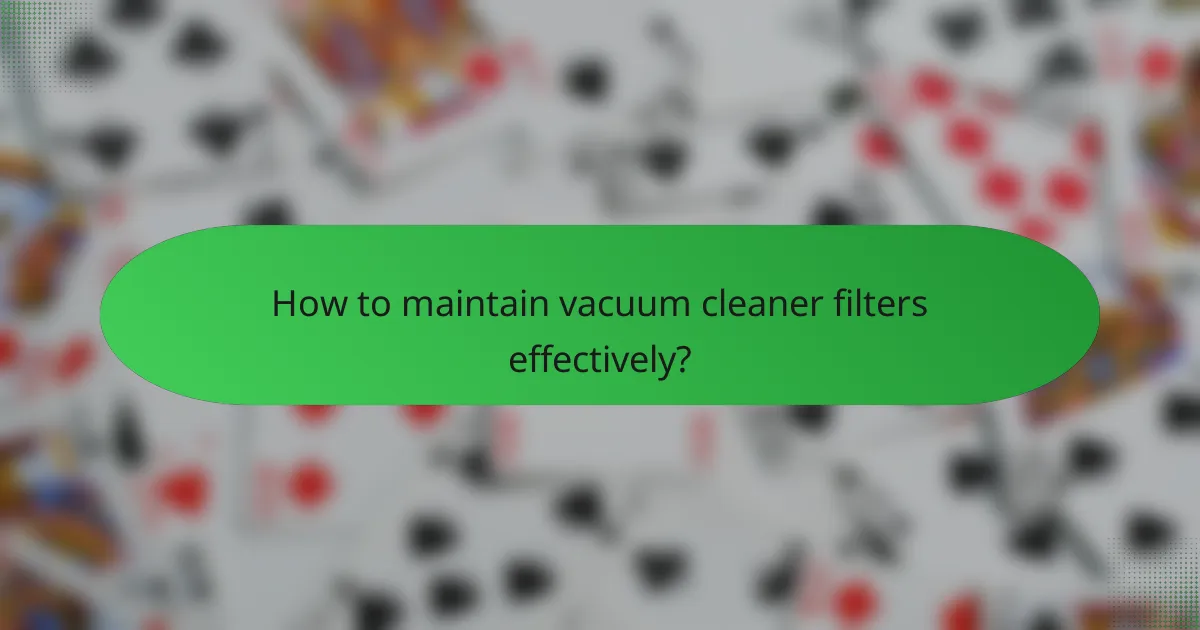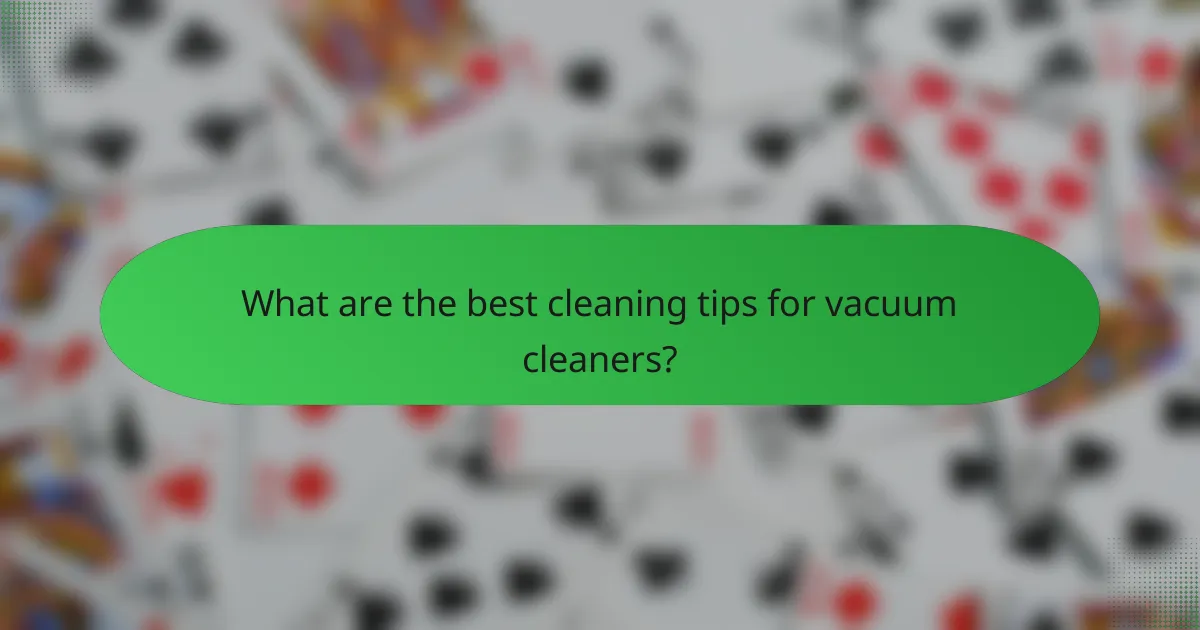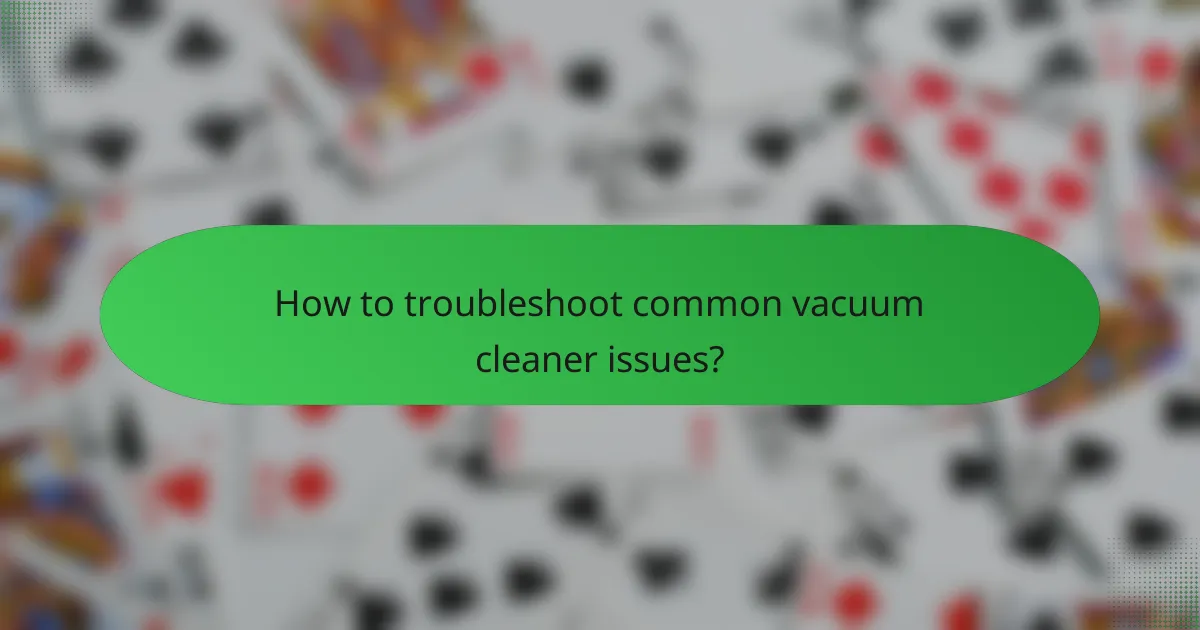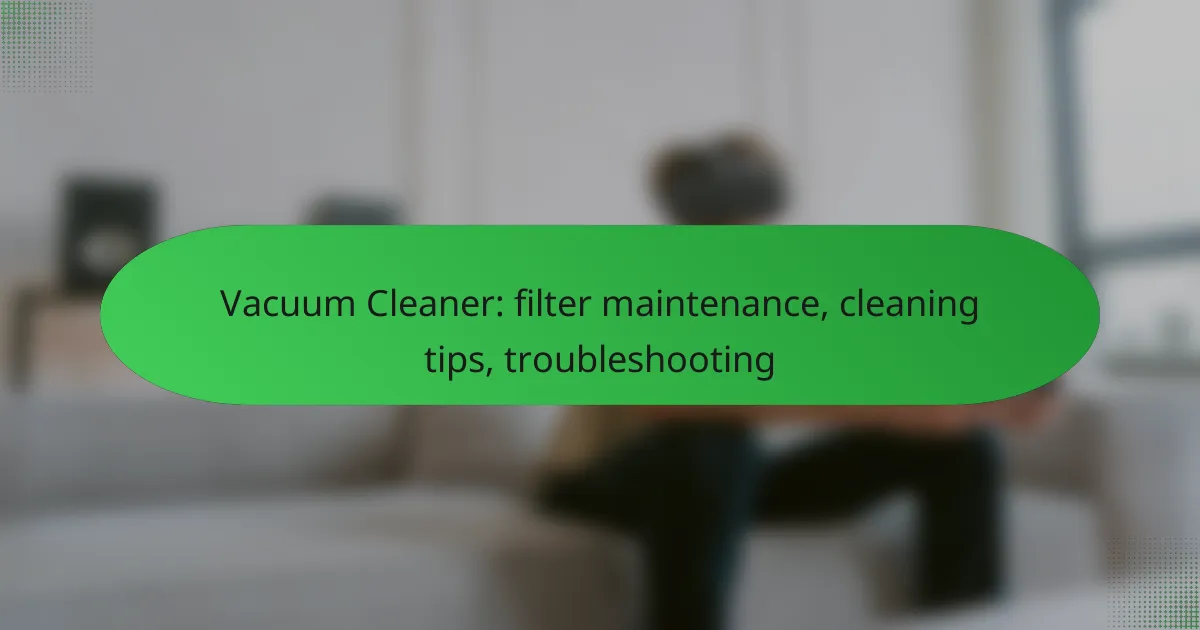Proper maintenance of vacuum cleaner filters is essential for ensuring efficient performance and prolonging the life of your device. Regular cleaning and upkeep, such as emptying the dustbin and maintaining brush rolls, can significantly enhance suction power and reduce the circulation of dust and allergens in your home. Additionally, being proactive in troubleshooting common issues will help you address problems quickly, keeping your vacuum running smoothly for years to come.

How to maintain vacuum cleaner filters effectively?
Maintaining vacuum cleaner filters is crucial for optimal performance and longevity. Regular upkeep ensures efficient suction and helps prevent dust and allergens from circulating in your home.
Regular filter replacement
Replacing vacuum cleaner filters regularly is essential to maintain suction power and air quality. Most manufacturers recommend changing filters every 6 to 12 months, depending on usage and model. Check your user manual for specific guidelines.
In high-traffic homes or those with pets, consider replacing filters more frequently, possibly every 3 to 6 months. Keeping a schedule can help you stay on track.
Cleaning reusable filters
If your vacuum cleaner has reusable filters, cleaning them is vital for maintaining performance. Typically, you should clean these filters every 1 to 3 months, depending on usage. Rinse them under cold water until the water runs clear, and allow them to dry completely before reinserting.
Avoid using harsh chemicals or scrubbing brushes, as these can damage the filter material. Instead, gently tap off any debris and let the filter air dry for at least 24 hours.
Checking filter compatibility
Ensuring filter compatibility with your vacuum model is crucial for effective operation. Always refer to the manufacturer’s specifications when purchasing replacement filters. Using incompatible filters can lead to reduced suction and potential damage to the vacuum.
Check the model number on your vacuum and match it with the filter specifications listed on the packaging. If in doubt, consult customer service or the manufacturer’s website for guidance.
Signs of filter wear
Recognizing signs of filter wear can help you maintain your vacuum cleaner effectively. Common indicators include reduced suction power, increased noise levels, or visible damage such as tears or holes in the filter material.
If you notice any of these signs, it’s time to replace or clean the filter. Regularly inspecting your filters can prevent performance issues and extend the life of your vacuum cleaner.

What are the best cleaning tips for vacuum cleaners?
To maintain optimal performance, regularly clean your vacuum cleaner by following essential tips. This includes emptying the dustbin, cleaning brush rolls, and using the right attachments for various surfaces.
Emptying the dustbin regularly
Regularly emptying the dustbin is crucial for maintaining suction power and overall efficiency. Aim to empty it when it reaches about two-thirds full to prevent clogs and reduce strain on the motor.
When disposing of the dust, do so outdoors if possible to minimize dust exposure indoors. Ensure the dustbin is properly reattached before using the vacuum again to avoid spills.
Cleaning vacuum brush rolls
Cleaning the vacuum brush rolls helps maintain their effectiveness in picking up dirt and debris. Check the brush rolls for tangled hair or fibers at least once a month, especially if you have pets.
To clean, remove the brush rolls according to your vacuum’s manual, and use scissors to cut away any entangled material. Wipe them down with a damp cloth to remove dust and grime.
Using appropriate attachments
Using the right attachments can significantly enhance your vacuum cleaner’s performance on different surfaces. For instance, use a crevice tool for tight spaces and an upholstery brush for furniture.
Refer to your vacuum’s manual for guidance on which attachments are best suited for specific tasks. This not only improves cleaning efficiency but also protects your surfaces from damage.

How to troubleshoot common vacuum cleaner issues?
Troubleshooting common vacuum cleaner issues involves identifying symptoms and taking appropriate steps to resolve them. Regular maintenance and prompt attention to problems can enhance performance and extend the lifespan of your vacuum.
Loss of suction
If your vacuum cleaner is experiencing a loss of suction, it may be due to a clogged filter, a blocked hose, or a full dust container. Start by checking and cleaning the filter, as many models require regular maintenance to function effectively.
Inspect the hose for any obstructions and ensure that the dust container is emptied frequently. A good rule of thumb is to empty the container when it reaches about two-thirds full to maintain optimal suction.
Strange noises
Strange noises from your vacuum can indicate a problem, such as a foreign object lodged in the brush roll or a worn-out motor. Listen for high-pitched sounds or grinding noises, which often signal that something is wrong.
To troubleshoot, turn off the vacuum and inspect the brush roll for debris. If the noise persists after removing any blockages, it may be necessary to consult the manufacturer or a professional for motor issues.
Power issues
Power issues can manifest as the vacuum not turning on or shutting off unexpectedly. First, check the power cord for any visible damage and ensure it is plugged into a functioning outlet. If the cord appears intact, the issue may lie within the vacuum’s internal components.
For corded models, consider testing the outlet with another device to rule out electrical problems. For battery-operated vacuums, ensure the battery is charged and properly seated. If problems continue, contacting customer support may be necessary for further diagnostics.

What factors should be considered when selecting a vacuum cleaner?
When selecting a vacuum cleaner, consider factors such as the type of flooring in your home, how you manage pet hair, and the types of filters available. These elements will significantly influence the performance and efficiency of your vacuum cleaner.
Type of flooring
The type of flooring in your home is crucial when choosing a vacuum cleaner. For hardwood or tile floors, a vacuum with a soft brush roll or a hard floor setting is ideal to prevent scratches. In contrast, if you have carpets, look for a vacuum with strong suction and a beater brush to effectively lift dirt and debris.
Additionally, consider whether your flooring includes area rugs or mixed surfaces. A versatile vacuum with adjustable settings can handle various floor types, ensuring thorough cleaning throughout your home.
Pet hair management
If you have pets, effective pet hair management is essential. Look for vacuums specifically designed to tackle pet hair, often featuring specialized attachments and stronger suction capabilities. These models typically include tangle-free brush rolls that prevent hair from wrapping around the brushes.
Regular maintenance, such as cleaning the brush rolls and filters, is also vital to keep your vacuum performing well. Consider models with easy-to-empty dustbins to simplify the cleaning process after vacuuming pet hair.
Filter types
Filter types play a significant role in the performance and maintenance of a vacuum cleaner. Common filter types include HEPA filters, which trap allergens and are ideal for allergy sufferers, and foam or sponge filters, which are easier to clean but may not capture as many particles.
When selecting a vacuum, consider how often you are willing to replace or clean the filters. Some models offer washable filters, which can save money over time, while others require regular replacements. Always check the manufacturer’s recommendations for filter maintenance to ensure optimal performance.

What are the emerging trends in vacuum cleaner technology?
Emerging trends in vacuum cleaner technology focus on automation, sustainability, and enhanced cleaning efficiency. Innovations such as smart features, eco-friendly designs, and advanced filtration systems are reshaping how consumers approach cleaning tasks.
Smart vacuum cleaners
Smart vacuum cleaners utilize technology to enhance user convenience and cleaning effectiveness. These devices often connect to Wi-Fi, allowing users to control them via smartphone apps or voice commands through smart home systems.
Features like scheduling, mapping, and real-time monitoring enable efficient cleaning routines. For instance, some models can learn the layout of your home and optimize their cleaning paths, reducing the time spent on chores.
Eco-friendly models
Eco-friendly vacuum cleaners are designed with sustainability in mind, often using energy-efficient motors and recyclable materials. These models aim to reduce environmental impact while maintaining strong cleaning performance.
Many eco-friendly vacuums are certified by energy standards, ensuring they consume less power. Brands may also offer models that use biodegradable bags or no bags at all, minimizing waste and promoting greener practices in households.
Advanced filtration systems
Advanced filtration systems in vacuum cleaners are crucial for improving indoor air quality. High-Efficiency Particulate Air (HEPA) filters are now standard in many models, capturing fine dust and allergens effectively.
Some vacuums incorporate multi-stage filtration, which can trap even smaller particles. When choosing a vacuum, consider models with washable filters to reduce replacement costs and maintain optimal performance over time.
